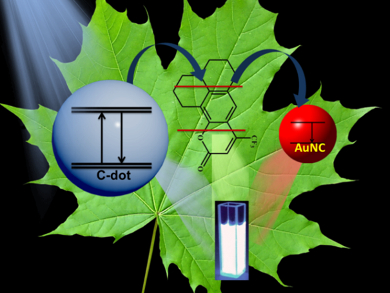In natural photosynthesis, light is absorbed by a complex molecular arrangement of chlorophyll molecules (the so-called light-harvesting complex). The light’s energy is efficiently transferred to a reaction center for the final generation of adenosine triphosphate (ATP). For several decades, researchers have tried to mimic this sophisticated design, which has evolved to near-perfection over millions of years.
Amitava Patra and colleagues, Indian Association for the Cultivation of Science, Kolkata, designed a light harvesting complex based on a composite of positively charged amine-capped carbon dots and negatively-charged bovine-serum-albumin-capped gold nanoclusters. An organic coumarin dye was incorporated into the composite to facilitate the energy transfer between the materials, comparable to chlorophyll in the natural photosynthesis. Interestingly, the emission wavelength of the light that is emitted from the composite after the light-harvesting process can be tuned by varying the relative ratios of the constituents.
- Light Harvesting and White-Light Generation in a Composite of Carbon Dots and Dye-Encapsulated BSA-Protein-Capped Gold Nanoclusters,
Monoj Kumar Barman, Bipattaran Paramanik, Dipankar Bain, Amitava Patra,
Chem. Eur. J. 2016.
DOI: 10.1002/chem.201601849




